Franklin Steam Academy Students Experience High-Tech Science at MRL
March 27, 2019
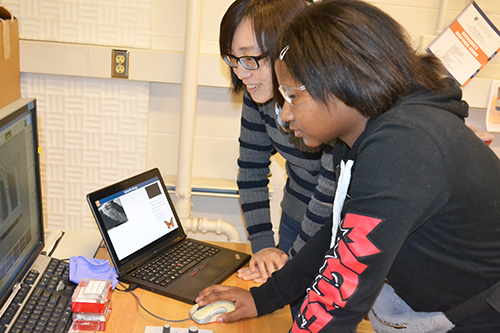
MRL's Jade Wang works with a Franklin eighth grader using MRL's Scanning Electron Microscope (SEM) during their visit to MRL.
On February 25th, Franklin STEAM Academy eighth grade students took a break from their science textbooks to experience some real-world, high-tech science first hand during a visit to MRL (the Materials Research Lab), home of I-MRSEC (the Illinois Materials Research Science and Engineering Center). The field trip was one of the highlights of I-MRSEC’s “Musical Magnetism,” a multi-disciplinary curriculum that used rap and music to expose students to materials science and magnetism. At MRL, the university folk pulled out all the stops, proudly introducing the youth to some of their million-dollar equipment and exposing them to some of the cool stuff they do—all while practicing another of I-MRSEC’s main emphases: scientific communication.
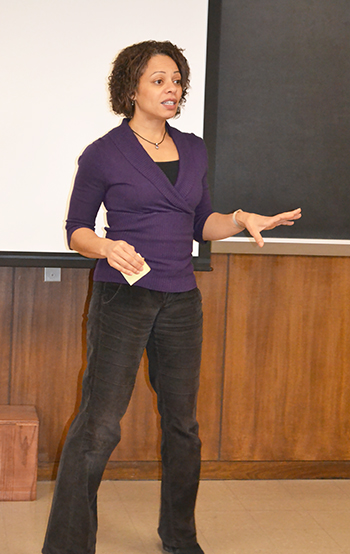
Nadya Mason, I-MRSEC PI, welcomes the Franklin students to MRL.
I-MRSEC PI Nadya Mason explains why a visit to MRL was incorporated into the curriculum.
“A lot of the kids had never been to the University of Illinois before,” she reports. “Their school is a mile away, yet they've never been on campus. They've never been to the College of Engineering; they've certainly never been to a lab before.”
So she and the Musical Magnetism curriculum planners decided to expose the young people to some of the cutting-edge equipment and exciting opportunities available just down the road from their school.
After a brief introduction by Mason, who welcomed the students to MRL and encouraged them to take advantage of the opportunity, Maisie Kingren, a safety engineer at MRL gave the group some lab safety protocols—and outfitted them with safety goggles. Then the group was divided into six smaller groups, who rotated through different activities throughout MRL to experience what some of the different scientists and instruments do.
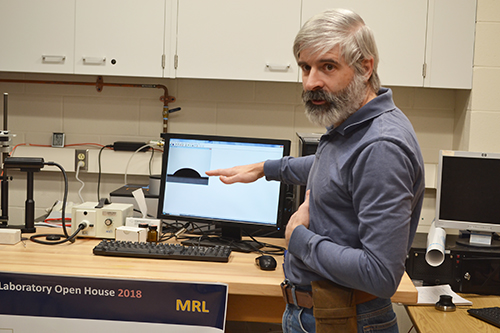
Senior research scientist Julio Soares demonstrates to STEAM Academy eighth graders how the contact angle goniometer analyzes the shape of drops of liquid.
For example, in one lab, students experienced a 3D Optical Profilometer, a special tool that uses light to make a finely detailed image of an object. Then students were encouraged to choose from variety of samples and measure them using the profilometer. Another instrument, a contact angle goniometer, let students look at drops of liquid up close to see what their shapes were. They discovered that a drop of water can take on very different shapes, from very flat to almost shaped like a ball, based on how it interacts with the surfaces of various materials.
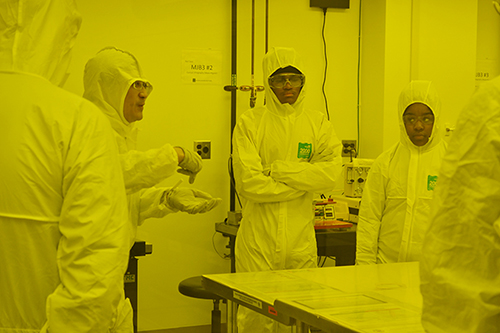
Franklin STEAM Academy eighth graders experience MRL's cleanroom.
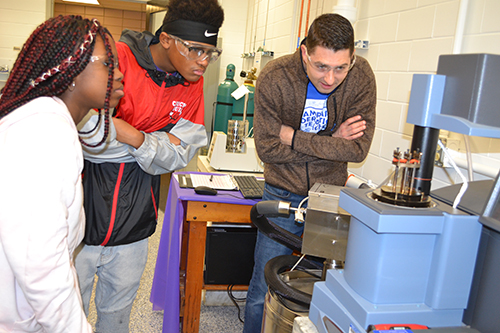
Franklin students and their teacher experience dynamical mechanical analysis of a common snack food.
Students also got to tour MRL’s cleanroom. Since anyone who enters this lab must completely cover their body in order to prevent dust, skin cells, hairs, or other contamination from entering the lab, the students suited up in cleanroom suits, safety glasses, and gloves, then got to see what’s inside the clean room and to hear about some of the experiments conducted there. Not only that, the students got to take their cleanroom suits home!
In the DMA (Dynamical Mechanical Analysis) lab, the students learned about equipment that analyzes how much force it takes to break different materials by studying a number of different materials, including snacks, to see how strong they are.
Another high-tech piece of equipment the Franklin students learned about then used was Focused Ion Beams (FIB), which allow scientists to cut or sculpt things the size of a human hair or less using something even smaller—atoms! Using FIB, scientists can hit a small area of a sample with atoms in order to knock off pieces of the sample. At MRL, students used the FIB to make pillars and even small pictures in a piece of silicon.
During a Scanning Electron Microscope (SEM) activity, students first examined a butterfly wing using a small optical microscope, and then got see it through the SEM’s much higher magnification. They even got to help run the SEM and control which parts of the sample to look at.
Franklin eighth grade students also got to use an X-ray Diffraction instrument, which scientists use to learn what materials are made of and how a given substance's atoms are arranged. For instance, many everyday materials, such as salt, sugar, and sand, are crystalline— constructed of layers of atoms stacked on top of each other in a pattern. Small enough to go between these layers and bounce off, an X-ray Diffraction instrument tells scientists how close the layers are and what types of atoms they’re comprised of based on the angles that the X-rays bounce off. This allows scientists to tell the difference between, say, salt and sugar.
 MRL Postdoc James Lee demonstrates to Franklin eighth graders how an X-ray Diffraction instrument works during their visit to MRL.
MRL Postdoc James Lee demonstrates to Franklin eighth graders how an X-ray Diffraction instrument works during their visit to MRL.
Operating the X-ray Diffractor was James Lee, an MRL Postdoc who saw the visit as a very exciting opportunity for the students. According to Lee, it allowed them to “make contact with the very same instruments and devices that researchers at the cutting edge of research use on a daily basis. It can be extremely inspiring. The idea that you are using the exact same things used in the frontier of science can help middle schoolers or high schoolers envision a future for themselves in which they are doing science or engineering. It's a small taste, but I hope it makes a lasting impression.”
Last, but not least, the Franklin students got to experience Virtual Reality (VR), which some of MRL’s scientists use to study molecules. Armed with a controller and geared up in a VR headset, during this demo, students got a 3D look at molecules and other structures and were even able to move them around to see what the inside of the material looks like.
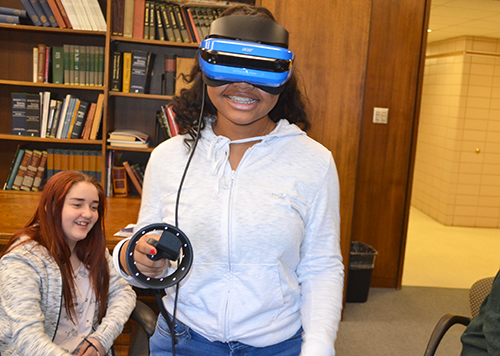
A Franklin eighth grader experiences virtual reality.
One I-MRSEC student who probably uses VR in his research, which involves the simulation of nanomaterials, is Emil Annevelink. The 3rd year PhD student was on hand to help escort the students from place to place. He shares that one of the benefits of bringing the students to MRL was “to expose them to science in a way that they will probably never experience in a middle school setting. Being able to show them million-dollar equipment that is just not available in any other setting than a university or a national lab.” He adds that the idea was “For them to see some of the cool, high-profile technologies that they would never see, to expose them to the possibilities of what science can do, and some of the cutting-edge things that we have here at Illinois.”
Annevelink also believes the exposure could pique some of the students’ interest in STEM. He reports that research has shown that while high school students have already pretty much decided what they want to do, and elementary students haven’t really begun thinking about the future, middle school students are poised to decide their future career paths.

Emil Annevelink interacts with Franklin eighth graders during one of the Musical Magnetism sessions.
“Middle school students are at a specific point where they're thinking of options but not necessarily going down any yet,” he explains. “So when presenting science and technology as an option to them, they will consider it much more realistically. I think bringing them on campus is really good for making it a concrete option.”
Regarding the benefit of a multidisciplinary curriculum like Musical Magnetism, Annevelink indicates that connecting science (specifically magnetism), art, and music can “encourage students to engage with science in a way that they don't normally do. A lot of students enjoy music and enjoy science, but not necessarily together. So being able to see that you can learn both music and science simultaneously, I think, stretches the brain in a way that I was never exposed to.” He also believes the multidisciplinary emphasis might be able to “catch some students who might not like one or might not like the other. So you can kind of get the synergistic benefit of students who might enjoy one to then maybe be interested in the other and vice versa.”
Story by Elizabeth Innes, Communications Specialist, I-STEM Education Initiative. Photos by Elizabeth Innes, unless noted otherwise.
For more I-STEM web articles about I-MRSEC, see:
- I-MRSEC’s Musical Magnetism Curriculum Uses Hip Hop to Teach Science
- I-MRSEC, Champaign Educator Jamie Roundtree, Embrace Hip Hop/Rap to Reach Youth at Their Level
- Polímeros! Cena y Ciencias Program Teaches About Materials Through a Supper & Science Night
- I-MRSEC: Creating a Multidisciplinary Materials Research Community
More: 6-8 Outreach, I-MRSEC, 2019

MRL Postdoc James Lee by MRL's Diffraktometer D6000.
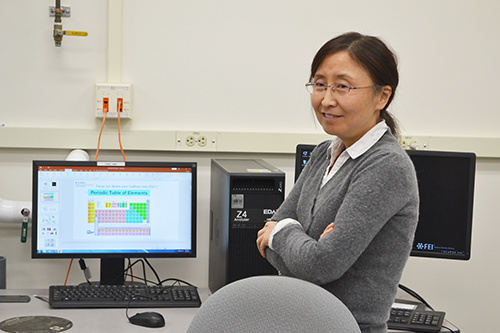
MRL research scientist Honghui Zhou explains to Franklin STEAM Academy student how Focused Ion
Beams are used in research.













.jpg)
















